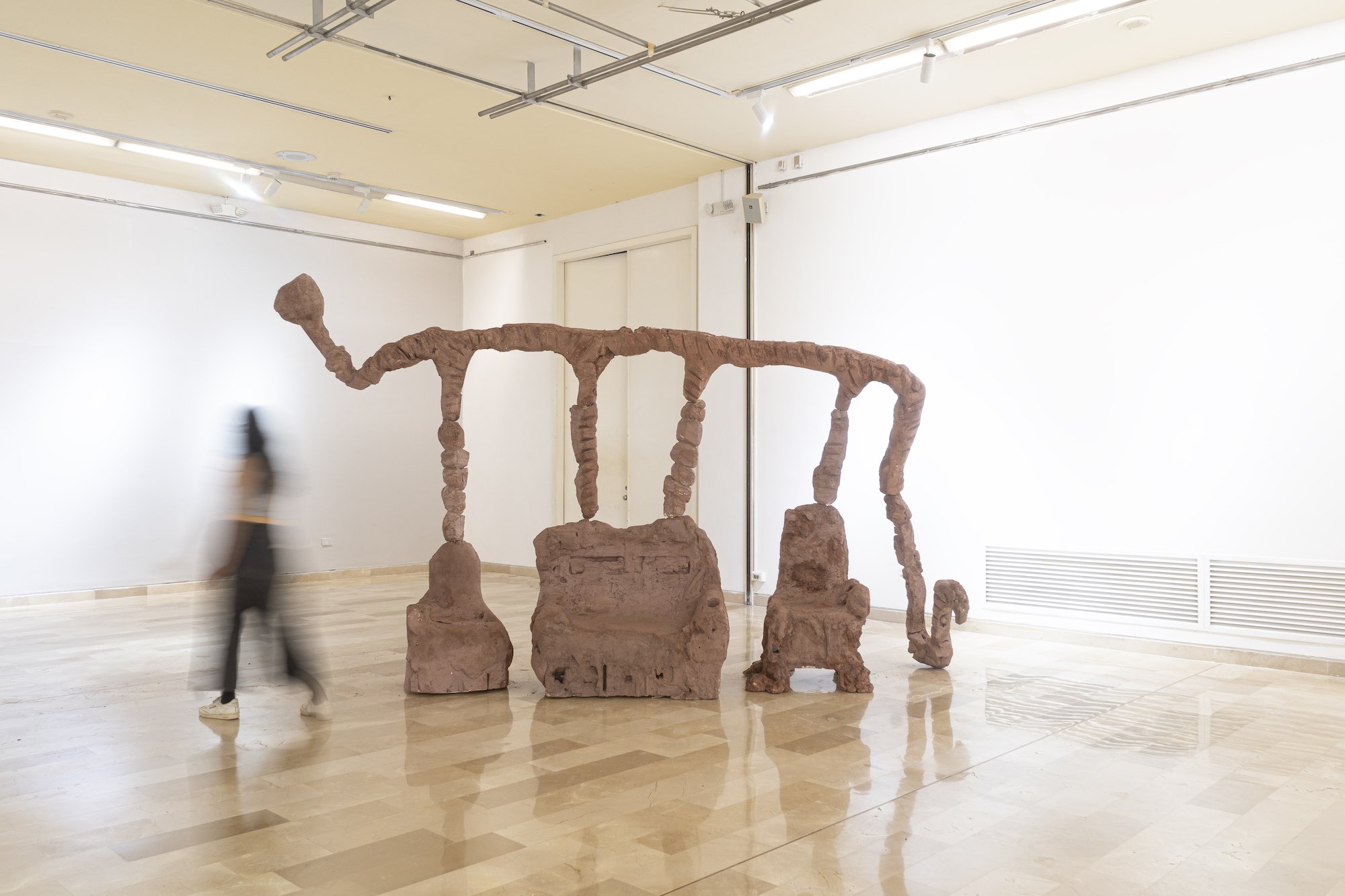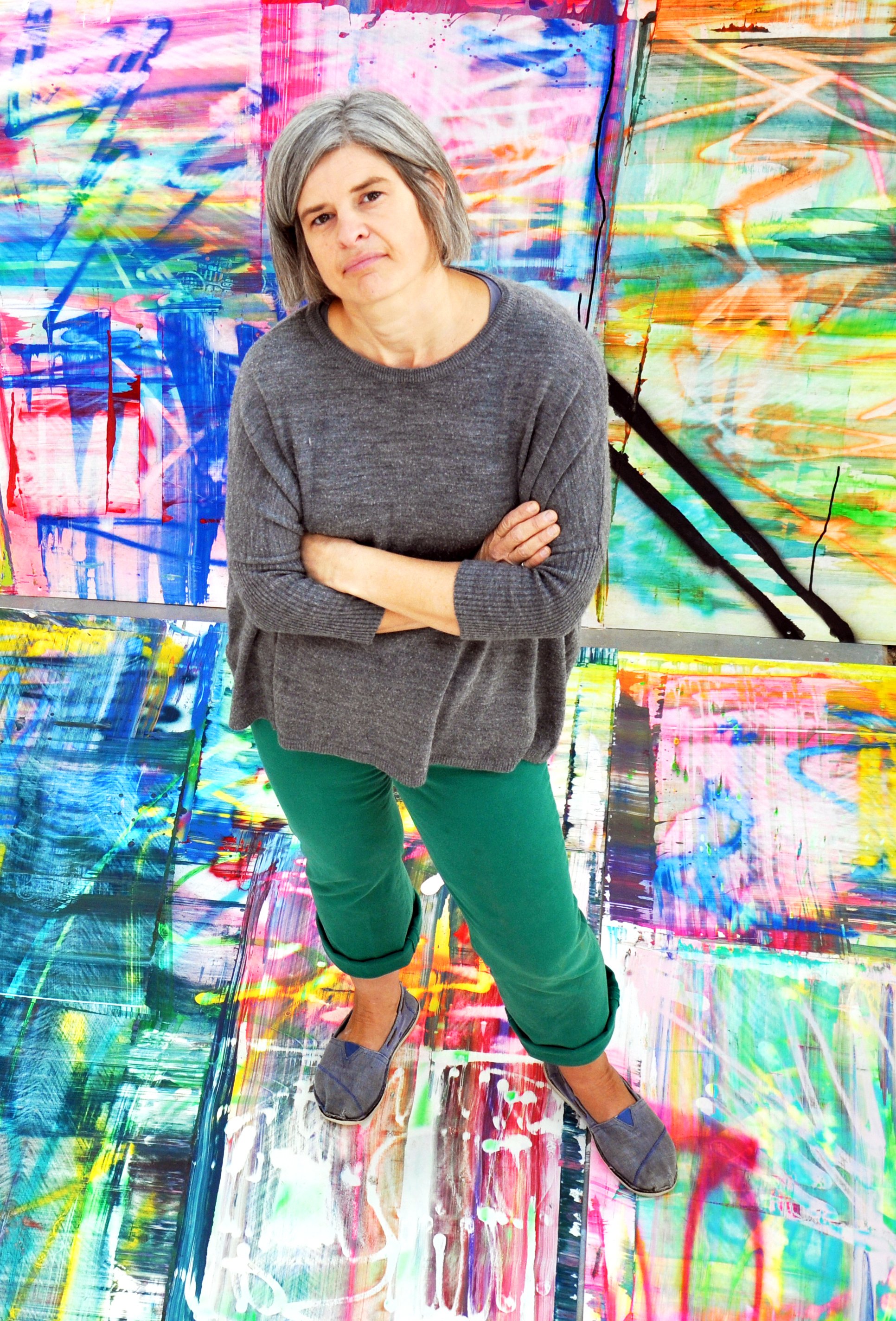kg weaves words, threads, and objects of the every day to form a practice that draws upon narratives, poetry, and sincerity.
When I entered kg’s weaving class in January of 2022, I was drawn first to a mighty stack of books at the back of the studio. kg had arrived with an entire traveling library (though they clarified it was only a 12th of their collection). Over the years, these books have served as objects of sentiment and inspiration to kg’s practice and method of instruction. “I don’t actually assign readings,” they said. Instead, they talk about the possibilities with their students and allow them to mutually agree upon the texts they’ll engage together. After only a brief conversation with kg that January, I left with multiple book recommendations. The readings eventually selected for their courses are “the result of the conversations that are happening between students.” This in turn creates a course, a syllabus, a series of conversations custom fit to the community of learners. With this background in mind, I knew kg was an ideal facilitator for Longform, a residency built upon long talks, walks, conversation, and contemplation.
As kg and I talked again this August, they returned over and over to the idea of objects and their meanings. This connection was planted, kg theorizes, when they immigrated from Poland to America as a child. They recalled packing their suitcase, knowing they were headed to a land that had everything they’d need. What does one pack when all they’ll need is waiting on the other side? kg doesn’t remember what ended up in their bag, but they do know it was dictated by an ethic of personal value rather than economics.
As an individual in tune with the material, kg tends diligently to their studio. It is a sacred space, and even as they have moved from one to another over the years, the soul of these spaces has been preserved through kg instincts and care. “You are who you are wherever you are,” kg jested when they talked about the carryovers from studio to studio. Over the years, kg has consistently worked from the ground. I don’t mean this metaphorically; they work from a coffee table and sit on the floor. This falls in line with many weaving predecessors that they saw depicted in their library collection over the years, but it also came naturally to kg. They connect the instinct to the extension of their inner child playing on the floor. Play, kg stresses, is an essential ingredient to their practice.
Cleanup Time, 2021, 7” x 9”
Bleach soaked cotton stripes
strung with
Donettes
stabbed through with this old dog’s nose
While this childlike element is in their spirit, so too are more reverent notions, ones that I’m confident kg would insist are in partnership with, not contradiction, to that inner child. The most clear example of this can be found in their publication Some Kind of Duty, an artist book that draws its name from two sources. The first, a quote from Joan Didion on the process of going through a deceased loved one’s closet; the second, kg admitted with a smirk, is a poop joke.
One of my favorite aspects of kg’s works are the material lists. These too are a haven of humor and heart. If you haven’t encountered their work, I’m sure this sounds odd. Let me explain… Rather than listing the face value of the materials – wool, willow branch, latex balloon, plastic bag – they opt for a more poetic interpretation. Ordinary plastic bags become “bags filled with shit near the twigs with no skin.”
Blue Eye, 2018, 10” x 19”
the bone
from a tiny chicken for two
on carpet
fibers with wool swirling round
and a thanks from the smokes
kg’s emphasis on poetics started in the mid 90’s, when kg was in grad school. Many of their professors were staunch modernists, bent towards the traditional. While many of them were averse to kg’s manipulation of the material list, the professor leading textiles ran counter culture. “She said yes first and worry about it later,” kg said. Her permissive and encouraging nature gave kg the freedom to explore their attraction to titles and the stories attached to objects. “I was working with such meaningful material,” kg stressed, and the poems provided a vessel to store and document the sentimentality, narrative, and humor that runs abundant through their work.
One of my favorite material lists includes “the bone//from a tiny chicken for two” and “a thanks from the smokes.” kg considers these material lists not just poetical, but true poems. Part of their process includes scribbling words on sticky notes that travel with the objects as they make their way in and out of weavings. “If I take that material out and say it looks better in this weaving, the post-it goes with it,” kg explained. Objects and words form kinships and travel together. Sometimes poems surface at 15+ lines and extend far beyond a four inch weaving. Rather than dwarfing their weavings by hanging the material list directly on the wall, kg took inspiration from the dilemma. They have created several poetry chapbooks at their exhibitions that pair the weavings with their intended material list.
An American Prayer, 2018, 12” x 13”
“I wanted to be romanced,” kg said, when describing their encounters with other artists’ material lists. Instead they more often detracted from their encounters with work. In contrast, kg romances viewers relentlessly with words. These atypical material lists also keep the mystery alive. Rather than explaining the magic tricks at play, kg chooses a method that elevates, rather than reduces, the spellbinding encounters.
These poems direct viewers towards the sentiments that one could overlook if only accessing the weaving. An American Prayer is paired with the following:
Ariels dark tide snaking through
silks blended with mouse grey cotton around
two moths in moon lit Caran d’ache and a
big
foamy
Bud
This piece in particular grabs my attention because of the way both the weaving and the words guide viewers in serpentine style. It creates a spirit and reads to me like a spell to speak over the gallery space.
I hope that someday you receive the enchanting experience of witnessing kg’s works in the wild. For now, should you long for a taste of it, you can view many of their weavings and poetry alongside one another at karolinagnatowski.com. May your encounters be spellbinding.
kg (b.1980, Poland) makes weavings and writes poetry from their home studio by the lake in Chicago. kg values the small the domestic and the everyday, situating those politics in their studio and curatorial practices. They have exhibited work with Horse and Pony (Berlin), The Brooklyn Academy Of Music, The Bruce High Quality Foundation and The Gowanas Ballroom (New York), Left Field Gallery and Adjunct Positions (Los Angeles), Katherine E. Nash Gallery (Minneapolis), Monique Meloche Gallery, Gallery 400, Julius Caesar and LVL3 (Chicago), The John Michael Kohler Art Center (Wisconsin) and their most recent solo exhibition, Here Comes That Feeling at Hawthorne Contemporary in Milwaukee. Some Kind Of Duty, their expansive weaving survey hosted by The DePaul Art Museum is available as a monograph through the museum shop and online. In 2017 kg attended The Skowhegan School of Painting and Sculpture and The Vermont Studio Center as a fellow in 2018. Future exhibitions include Intranarratives hosted by the Musée d'art Contemporain de Montréal. Currently they are Artist in Residence at Chicago’s print studio, The Donut Shop and just curated Dog Show at Arts Of Life in Chicago and Small Wonders at NIAD in California. You can see their work now in Amuleto, hosted by The Hyde Park Art Center, The Franklin and The Mayfield in Chicago.
This article was written by Engagement Liaison & Storyteller, Shanley Poole and was based on an interview conducted by the author.









































